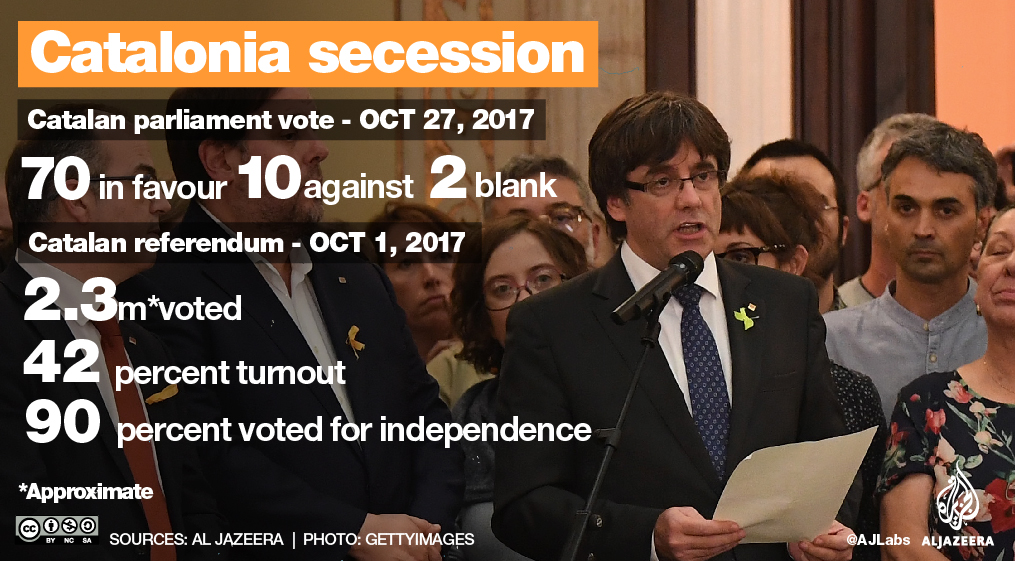Thousands celebrate Catalonia independence declaration
Fireworks and toasts ring out in Barcelona as secession supporters applaud independence declaration.

Barcelona – Moments after the parliament of Catalonia voted to secede from Spain, its capital city Barcelona exploded in the sounds of fireworks, car horns and toasts.
The city was abuzz with excitement over the declaration, and the Citadel Park was packed with thousands.
Keep reading
list of 4 itemsDivisive Catalan amnesty bill clears parliamentary hurdle in Spain
Large protests against Catalan amnesty deal in Madrid after PM sworn in
Thousands protest against Catalan amnesty in Spain
The park, found on the outskirts of Barcelona’s old city, is the location of the Catalan parliament, where secessionist legislators voted in secret to leave Spain.
The area around the park was so full of revellers celebrating Catalonia’s independence that Barcelona’s police closed streets. Public transportation was forced to re-route.
“Due to extraordinary circumstances, the stop has changed,” a public bus scrolling marquee said.
“It’s an adventure,” Joan, a man riding the bus on his way to the celebration who did not give his last name, said.
“And it looks like we have company.”
A parade of Spanish national police vans was seen driving into the city centre. Spain had just approved Article 155, which allows the central government to assume direct control of the secessionist region.
Although many Catalan assumed a police crackdown similar to that experienced on the day of their disputed October 1 independence referendum, the Spanish National Police cordoned off central government buildings and stood guard.
A steady flow of people was marching towards the Citadel Park. Tens of thousands were chanting pro-independence slogans. Some were seated, eating food they purchased from nearby supermarkets, which were filled with people buying goods to celebrate.
‘I cannot describe how it feels’
The mood was festive as thousands of Catalans standing outside the parliament cheered when Catalan President Carles Puigdemont appeared on a large screen which was showing the news.
“Republic now!” they chanted.
Shortly after, Spanish Prime Minister Mariano Rajoy appeared on the same screen to the sound of jeers from the crowd. When he asked the people to remain calm, demonstrators erupted in screams.
A procession of firefighters who had finished setting up barricades walked through the crowd, some clad in the Estelada, the one-starred flag of the Catalan Republic, with smiles on their faces.
The crowd erupted in applause. When asked why he was so excited to see firefighters, 24-year-old Josep Vila replied, “because they’re our firefighters”.
![Catalan firefighters joined in on the celebrations. [Yves Herman/Reuters]](/wp-content/uploads/2017/10/80b175105408449bac57677c1e3ef81f_18.jpeg)
Marta Sol, a woman in her 60s with an Estelada draped over her shoulders, told Al Jazeera these were the happiest moments of her life: “I’ve been waiting since I was a teenager to see this. I cannot describe how it feels.”
Flags played an important role in the celebration. Of the tens of thousands grouped around the Catalan parliament, many wore the Catalan flag on their shoulders.
But, it was the lack of the Spanish flag on the Catalan parliament that was perhaps most noticeable to the Catalans demonstrating at the Citadel Park. Someone had taken it down after the declaration of independence.
Catalans voted in a disputed independence referendum on October 1 that was ruled illegal by the Spanish Constitutional Court and met with police violence.
The Catalan government said 90 percent voted for independence, but turnout was less than 50 percent.
‘Freedom!’
As the realisation that people were standing, at least for a moment, in an independent Catalan republic settled into the crowd, the focus changed to the imprisoned secessionist leaders Jordi Cuixart and Jordi Sanchez of Omnium Cultural and the National Catalan Assembly, respectively.
Sanchez and Cuixart have been held without bail in Madrid on charges of sedition since last Monday. The charges stem from their pro-independence organising.
“Freedom!” The crowd chanted as their image came across the large screen. Calls for their release continue to be a rallying cry for Catalan demonstrators.
“They’re still on our minds. We wish they were celebrating with us,” 32-year-old Nuria Garcia told Al Jazeera. “Now, we have liberty, and hopefully they will soon be free”.
As the crowd settled in for a long night and the noise of celebrations subsided, the sound of Spanish police helicopters became audible. For those celebrating, the helicopters were a sombre reminder of the political reality.
While Catalonia considers itself independent, Spain and the European Union (EU) do not.
‘Happy, but nervous’
A new network of community-based activism groups called the Committees for the Defence of the Referendum (CDR) was organised in the days before the October 1 referendum.
The CDRs declared today that their acronym now stands for “Committees for the Defence of the Republic”.
Ruben Martinez, an organiser from the CDRs, told Al Jazeera he feels “very happy but nervous for what could come.”
Rajoy told reporters that “Spain is a serious country and a great nation and we will not tolerate that a few people try to liquidate our constitution,” after the Spanish Senate voted to use Article 155.
The extent of Spain’s control of Catalonia is still not widely understood, as the article has never been used.
After holding an emergency meeting on Friday night, Rajoy announced the dismissal of Catalonia’s regional parliament and president. He called for a new regional election on December 21.
For Martinez, it is now the duty of the CDRs to engage in “nonviolent defence, and it’s going to be difficult.”
